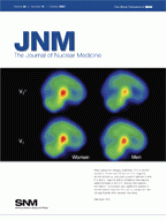REPLY:We thank Dr. Kumar and colleagues for their kind words about our paper (1). We wish to point out, however, that we are not proposing PET/MRI fusion as a screening technique. Rather, we encourage that it be used in those cases in which MRI has a specificity of 50% or less (2). Such cases include, but are not limited to, small invasive carcinoma and intraductal carcinoma (ductal carcinoma in situ), which may be missed on MRI; invasive lobular carcinoma, which is difficult to detect by physical examination, mammography, or sonography, and which might be either undetected or underestimated on MRI; tissue changes at a lumpectomy site; occult, multifocal, multicentric, or contralateral breast carcinoma; and patients with otherwise occult cancers who require confirmation of the primary tumor (3–5).
MRI is particularly recommended for early detection of breast cancer in women who are at increased risk for breast tumors because of family history, gene mutations such as BRCA1 or BRCA2, or prior radiation exposure or who are difficult to image mammographically, such as young women with dense breast tissue. As was noted in our paper, our patient population consisted of many such cases. Additionally, our method was unique in that we acquired the PET scan with the patient prone to better match the geometry of the MRI scan (6). We noted in our paper that small tumors were harder to detect with PET, and we also noted that for a particular range, the standardized uptake value was an unreliable indicator of whether cancer was present. One outcome of our research is to encourage the clinical development of simultaneous PET/MRI machines that will obviate fusion of separate PET and MR image volumes.
Footnotes
-
COPYRIGHT © 2007 by the Society of Nuclear Medicine, Inc.







